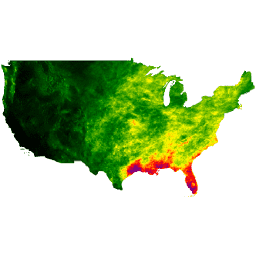
- 데이터 세트 사용 가능 기간
- 1991-01-01T00:00:00Z–2020-12-31T00:00:00Z
- 데이터 세트 제공업체
- PRISM / OREGONSTATE
- 기후학적 간격
- 1개월
- 태그
설명
PRISM 일일 및 월별 데이터 세트는 오리건 주립대학교의 PRISM Climate Group에서 생성한 미국 본토의 그리드형 기후 데이터 세트입니다.
그리드는 PRISM (Parameter-elevation Regressions on Independent Slopes Model)을 사용하여 개발됩니다. PRISM 보간 루틴은 고도에 따라 날씨와 기후가 어떻게 달라지는지 시뮬레이션하고, 해안 효과, 온도 역전, 강수량을 감소시킬 수 있는 지형 장벽을 고려합니다. 관측소 데이터는 전국 여러 네트워크에서 동화됩니다. 자세한 내용은 PRISM 공간 기후 데이터 세트 설명을 참고하세요.
대역
픽셀 크기
928미터
대역
| 이름 | 단위 | 최소 | 최대 | 픽셀 크기 | 설명 |
|---|---|---|---|---|---|
ppt |
mm | 0.03* | 1046.09* | 미터 | 30년간의 월별 총 강수량 (비와 녹은 눈 포함) 평균 |
tmean |
°C | -16.15* | 37.88* | 미터 | 월별 평균 기온의 30년 평균(tmin+tmax)/2로 계산) |
tmin |
°C | -21.9* | 29.79* | 미터 | 30년 월별 최저 온도 평균 |
tmax |
°C | -10.78* | 46.63* | 미터 | 30년간 월별 최고 기온의 평균 |
tdmean |
°C | -19.07* | 25.22* | 미터 | 월별 평균 이슬점 온도의 30년 평균 |
vpdmin |
hPa | 0* | 33.11* | 미터 | 월별 최소 증기압 부족의 30년 평균 |
vpdmax |
hPa | 0.37* | 94.11* | 미터 | 30년 동안의 월별 최대 증기압 부족 평균 |
solclear |
MJ m^-2 day^-1 | 미터 | 맑은 하늘 조건에서 수평면에 수신된 월별 전 세계 단파 태양 복사열의 30년 평균 |
||
solslope |
MJ m^-2 day^-1 | 미터 | 경사진 표면에 수신된 월별 전 세계 단파 태양 복사열의 30년 평균 |
||
soltotal |
MJ m^-2 day^-1 | 미터 | 수평면에 수신된 월별 전역 단파 태양 복사열의 30년 평균 |
||
soltrans |
분수 | 미터 | 30년간의 대기 투과율 (구름) 평균 |
이미지 속성
이미지 속성
| 이름 | 유형 | 설명 |
|---|---|---|
| PRISM_DATASET_CREATE_DATE | STRING_LIST | 각 밴드의 원래 생성 날짜 목록입니다. 예를 들어 첫 번째 요소는 첫 번째 밴드 'ppt'에 해당하고 두 번째 요소는 두 번째 밴드 'tmean'에 해당합니다. |
| PRISM_DATASET_TYPE | STRING_LIST | 밴드별 데이터 세트 유형 목록 |
| PRISM_CODE_VERSION | STRING_LIST | 대역별 코드 버전 목록 |
| PRISM_DATASET_FILENAME | STRING_LIST | 밴드별 원본 파일 이름 목록 |
이용약관
이용약관
이러한 PRISM 데이터 세트는 사용 또는 배포에 제한 없이 사용할 수 있습니다. PRISM Climate Group에서는 사용자가 적절한 출처 표시를 제공하고 해당되는 경우 PRISM을 데이터 소스로 식별하도록 요청합니다. https://prism.oregonstate.edu/terms/
인용
Daly, C., Halbleib, M., Smith, J.I., Gibson, W.P., Doggett, M.K., Taylor, G.H., Curtis, J., and Pasteris, P.A. 2008. 미국 본토 전역의 온도와 강수량을 지형학적으로 민감하게 매핑합니다. International Journal of Climatology, 28: 2031-2064 doi:10.1002/joc.1688 pdf.
[Daly, C., J.I. Smith, K.V. Olson. 2015년. 미국 본토 전역의 대기 수분 기후학 매핑 PloS ONE 10(10):e0141140. doi:10.1371/journal.pone.0141140.
DOI
Earth Engine으로 탐색하기
코드 편집기(JavaScript)
var dataset = ee.ImageCollection('OREGONSTATE/PRISM/Norm91m'); var precipitation = dataset.select('ppt'); var precipitationVis = { min: 0.0, max: 300.0, palette: ['red', 'yellow', 'green', 'cyan', 'purple'], }; Map.setCenter(-100.55, 40.71, 0); Map.addLayer(precipitation, precipitationVis, 'Precipitation');
